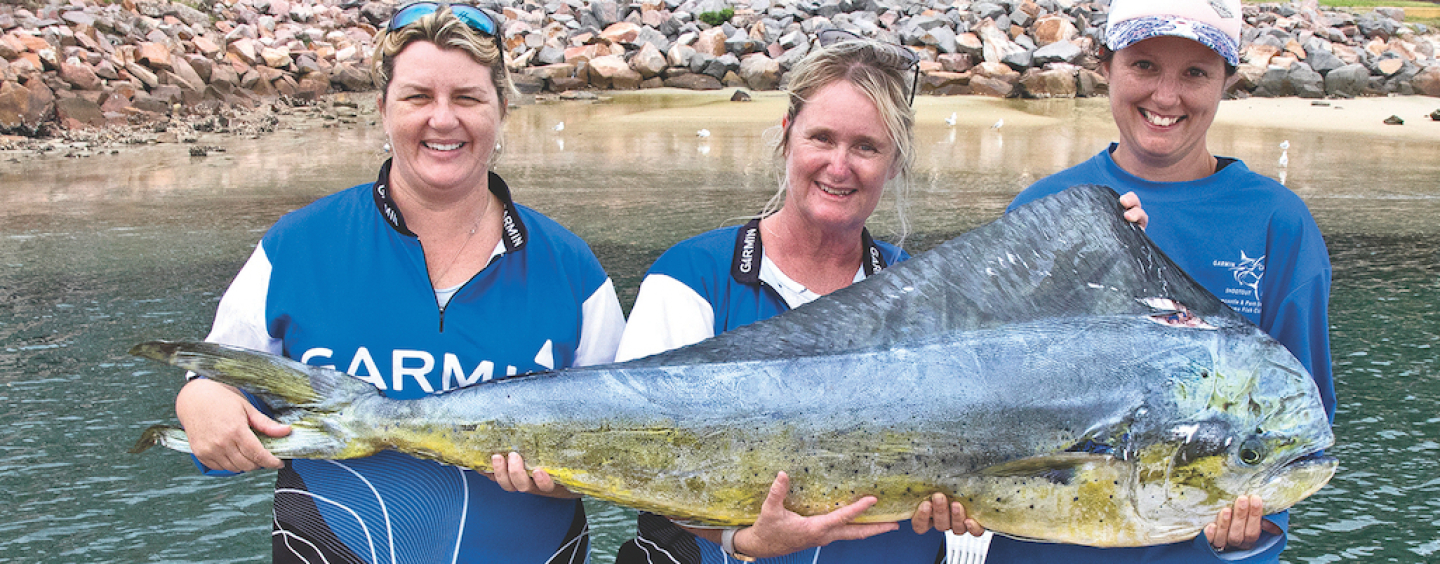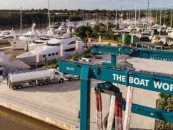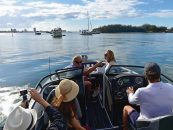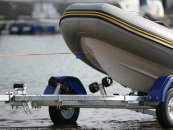Did you know that the broadbill swordfish has a gland near its eye that secretes special oil that is thought to make them even more slippery through the water? Until about a year ago, no one did! Also, did you know that the oceanic whitetip shark has special sensory structures in its head that act like a natural GPS utilising the earth’s geomagnetic field to locate itself in our vast oceans as it travels around the globe? Bet you didn’t.
So, you can imagine how excited scientist Arnault Gaulthier was when he learned that one of 130 boat fleet participating in the 2017 NSW Game Fishing Association’s (NSWGFA) Interclub tournament was bringing in a sample of that very specific species for him to analyse. Given their expansive migratory patterns, having one specimen to study is almost unheard of. And being taken only a couple of hours before it was brought to the weigh station just made it all that much better.
His own story is almost as interesting as that of the fish he studies. He was born on the French island of Reunion in the Indian Ocean, in between Mauritius and Madagascar, close to the shores of Africa. Arnault is a PhD student from the University of Queensland working on the electro-sensory system of sharks and rays.
“I have had the chance to work on quite a few exciting sharks over the course of the weekend. The oceanic whitetip shark is one of my favourites, and no one has really ever studied them before,” he states. “Looking at its sensory system is very exciting and to assesses its overall function. It can detect both prey and predators, and communicate with other animals to some extent. Most interestingly, it is also a kind of internal GPS, as some people put it, that the sharks use to navigate through the earth’s geomagnetic field.”
Dr Julian Pepperell, an independent marine biologist and author, is an expert on large pelagic fish, having dedicated 40 years of work in the area. He has been independent for 25 years, and conducts joint research with universities all over the world, supervises PhD students all around the country, and has international projects as well. He also works with the CSIRO, specifically on billfish, tuna, and sharks.
“At the same time as finding out exactly what that gland in swordfish does, we are now also going to see if it also exists in marlin. Overall, however, we now have over 1,000 tissue samples. In addition to being available for specific project work, they have been essential to around 50 studies that have been undertaken all over the globe.
“Conversely, some of the sharks are very slow to grow, which we know from all of the samples, and so they need looking after. All of this material is what is used to determine the sustainability of fishing, both recreationally and commercially,” said Pepperell.
“There are also records of 65,000 tags, and we now know that black and blue marlin live for up to 20 years. Even at one year old, they are 30kg heavy and 2m long, so they grow very quickly, having hatched from an egg the size of a pinhead. This includes striped marlin. So at four to five years they will be around 130kg. The only reason we have this sort of data is from all the research over the years, greatly assisted by game fishing tournaments.”
Yet, it is not all about the fishing, or the science, either. Dave Bye has been attending the NSWGFA for 46 years now, and remembers when Dr Pepperell first appeared. He’s from the Tahlee Ministries, which is right up the other end of the bay we all know as Port Stephens. He was the one who recognised that there was fish on offer in the early 70s, and he saw a way to feed people. At the beginning, both the Ministry and nursing homes benefitted from their collections. But in these litigious times, it is now only their community that reaps the gifts of the sea each year.
All in all the fishing went well, even if the overall numbers were less than in most other years. You certainly would not have known it by talking with the participants, either, for their smiles were as infectious as their love of life in general. They went out, mostly to the continental shelf, in everything from blinding sunshine and millpond like seas, to significant lumps and pouring rain – such was their enthusiasm.
So despite the challenges afforded by the weather, 54 marlin (all species) were tagged and released, and just four brought ashore for samples, eating, and also donation to the Ministry. The largest was a 151.9kg blue marlin. There were 22 impressive and fantastically sporting mahi-mahi that were tagged and released, with four of those also coming ashore. A massive 26.1kg male was a delight to see, and for those lucky enough to be at the table later, a complete treat too!
There were 10 shortbill spearfish tagged and released, and no captures. There were also 11 of the fast swimming striped tuna that were tagged, and also a handful brought ashore for the scientists, as per their request. Two of the ultra-quick wahoo were tagged and released, again with none captured. That leaves the sharks. One of course was the long-ranging oceanic white tip that helped out both the scientists and the Ministry in the end. The largest fish weighed for the tournament was the 256.1kg tiger shark.
In all, five sharks of various species were tagged and released, with three coming ashore. Two of those were ultimately donated to the Ministry, which means it was virtually a 100% usage rate across the board.
Winners were as diverse as the 130-boat fleet. There were male, female, junior and small fry categories of anglers, and they all seem to appreciate the new four-day format that encompassed one weekend, not two, as per previously. Ultimately, you cannot help thinking that we, the greater community could well have been the biggest winners, given the large crowds that attended the weigh station and all the material that the scientists were able to gather over the event.
Pantaenius Sail and Motor Yacht Insurance is proud to be back for its second year as a major sponsor of this terrific event. Not only do all the crews have a wonderful time out at sea, the fact that so much is learned, the vast majority of fish are tagged and returned to the sea. That the Tahlee Ministries processes much of the catch for either food or fertiliser just shows how sustainable and important all the activities are. Of course, any event needs volunteers and the Interclub relies on so many. Well done to them for making it all happen so smoothly.
If you have a game boat from trailable to large sportsfisher, aluminium plate or fibreglass, then you might want to investigate the only true, marine-originated, agreed value insurance policy from the crew that know boats. Go to www.pantaenius.com.au or call +61 2 9936 1670 today, and see why everything from superyachts to global cruisers, game boats to racing yachts select the all-risk policy that only Pantaenius can provide you with.
Cover image and text by John Curnow
Published story that appeared in the May-Aug 2017 edition, including images, also by John Curnow






























